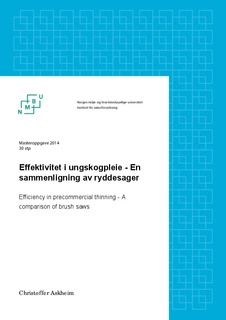| dc.description.abstract | Skogbruket i Norge har de siste 50 årene gjennomgått store forandringer. Både teknologiske
fremskritt og samfunnsøkonomiske faktorer har påvirket næringen betydelig. I dag er det om lag
6500 ansatte i skogbruket, og med relativt lave tømmerpriser er optimalisering og effektivisering
nødvendig i alle ledd, fra spiring til hovedhogst. Ungskogpleie er et kvalitetsfremmende tiltak
som ofte nedprioriteres. Det er anslått at behovet for ungskogpleie i Norge ligger rundt 2
millioner dekar, mens det årlige arealet som ryddes er omtrent 270 000 dekar. For å bidra til økt
effektivisering i ungskogpleie var målet med denne studien å kartlegge potensielle forskjeller for
tre ulike ryddesager produsert av Husqvarna AB (Husqvarna) knyttet til bestandsvariable. I 2009
lanserte samme produsent kjederyddesagen 535 FBx og det var også ønskelig å belyse andre
bruksområder for denne.
Nesten alle de 106 observasjonene er fra Eidsvoll kommune i Akershus fylke, og arbeidet ble
utført sommer og høst 2013. Bestandene ble valgt ut av oppdragsgivere og er derfor tilfeldig
utvalgt og ikke tilpasset studien. Observasjonene er delt i tre grupper; «Alle sager»; alle 106
observasjoner, Data-1; en stor tradisjonell ryddesag (555 FXT) mot kjederyddesag (535 FBx) (70
observasjoner), og Data-2 en svakere tradisjonell ryddesag (545 FXT) mot kjederyddesag (535
FBx) (36 observasjoner). Det ble utført tradisjonell avstandsregulering; enkelttrestilling. Det ble
brukt multippel regresjonsanalyse og det ble utarbeidet tre modeller, med uttak, gjennomsnittlig
diameter, og overhøyde som forklaringsvariabler.
Resultatene viser at ingen bestandsvariabler kan påvise prestasjonsforskjeller mellom de tre
forskjellige ryddesagene. Det er derfor ikke grunnlag for å anbefale en spesifikk sag for bestemte
bestandsvariabler. Modellene beskriver, med denne studiens datagrunnlag, prestasjonstider i
ungskogpleie for alle tre sagtyper. Andre bruksområder for 535 FBx er kunstig kvisting opp til ca
3 meter, rydding av traséer i skog, mer presis kapping av dobbelttopp og/eller gankvist,
toppkapping samt forhåndsrydding.
Abstract
Over the last five decades the forestry in Norway has changed significantly. Both technical and
socio-economic factors have influenced the industry. About 6500 persons are employed in the
forestry sector in Norway today, and due to the relatively low timber prices, the need for
optimization is necessary in all of the areas of the forestry industry, from germination to the final
harvest. Precommercial thinning is a quality improving work that often is forgotten. It is
estimated that the annual need for precommercial thinning in Norway is about 200 000 hectares,
while the mean annual precommercially thinned area is only 27 000 hectares. To help improve
precommercial thinning, the aim of this study was to locate possible differences linked to
different stand variables for different brush saws produced by Husqvarna AB (Husqvarna). In
2009, the company introduced a brush saw with a chain, the 535 FBx. It was also of interest to
comment on other possible areas of application for this saw.
Almost all of the 106 plots were established in Eidsvoll municipality, Akershus county. The
work was carried out during summer and fall 2013. The stands were picked out by the employers
and are therefore randomly chosen, and not adapted for this study. The observations were split
into three groups; "Alle sager" all of the 106 observations, Data-1; a large traditional brush saw
(555 FXT) versus the 535 FBx (70 observations), and Data-2; a smaller brush saw (545 FXT)
versus the 535 FBx (36 observations). The clearing method was traditional spacing; crop tree
selection. Multiple regression analysis was used to establish the models with stand density and
mean diameter as explanatory variables.
The results indicate that none of the stand variables could predict any difference between the
three different brush saws. It is therefore not possible to recommend one certain brush saw for
certain stand characteristics. With the data from this study, the models explain the operating time
in precommercial thinning for all of the three brush saws. Other areas of application for the 535
FBx is artificial pruning up to approximately 3 meters, clearing of lines and routes in forests,
more precise cutting of forks and/or spike knots, top cutting as well as clearing before
commercial thinning. | nb_NO |
